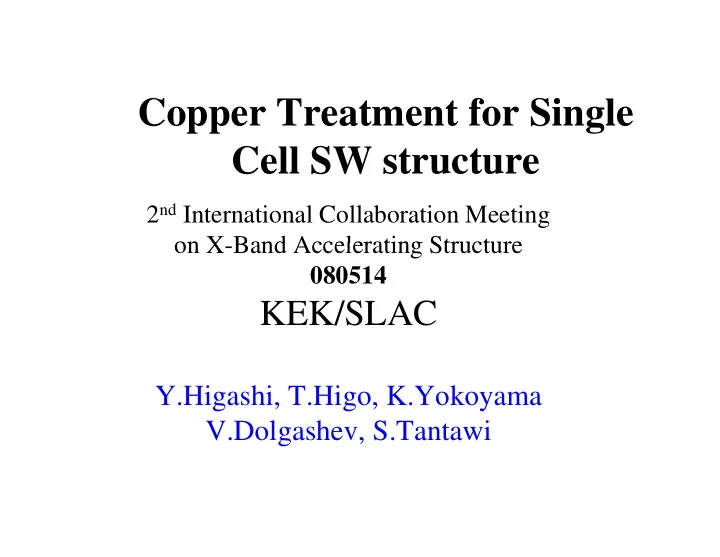

Copper Treatment for Single C T t t f Si l Cell SW structure Cell SW structure 2 nd International Collaboration Meeting on X Band Accelerating Structure on X-Band Accelerating Structure 080514 KEK/SLAC KEK/SLAC Y.Higashi, T.Higo, K.Yokoyama V.Dolgashev, S.Tantawi
Field Emission and RF Breakdown in High- Field Emission and RF Breakdown in High- Gradient Room-Temperature Linac Structure J. W. Wang and G. A. Loew SLAC-PUB-7685 October 1997 Pulse rf breakdown studies L. Laurent, G. Caryotakis, G. Scheitrum, D. Sprehn, N. C. Luhmann, Jr SLAC PUB 8409 SLAC-PUB-8409 March 2000
Purpose To find statistically high gradient limit for y g g copper materials by experiments
Who decide high gradient threshold ? � Magnetic field ? Fatigue crack nucleation and micro structure due to pulse F ti k l ti d i t t d t l heating � Electric field ? Dark current ( β of F-N plot) � Surface contaminations/ Crystal defects ? Dust, Copper oxide on surface � Vacuum level ? � Hardness, degradation and purity of material ? � Stored energy ?
Cyclic stress-strain Cyclic stress strain ref: ASM Handbook
Cyclic stress-strain ref: ASM Handbook
Evolution of fatigue slip b bands d N=4x10 3 cycling N=10 4 N=10 4 N=10 5 5
Fatigue slip band on the surface of cycled copper ref: ASM Handbook
Mechanism of Microcrack Nucleation ref: ASM Handbook ref: ASM Handbook
First electron microscope pictures of of 1C-SW-A5.65-T4.6-Cu-KEK-#2 20 March 2008
Grain boundary on iris of high-gradient cell Grain boundary in high electric field area Grain boundary in high magnetic field area Lisa Laurent, 20 March 2008
Cracks between grains and deformation of the grain on outside wall of high gradient cell θ γ 12 γ 12 γ 12 γ 12 γ 11=2 γ 12cos( θ /2) γ 11 Lisa Laurent, 20 March 2008
Scattering of conductive electrons due to grain b boundary and dislocation (speculation) d d di l ti ( l ti ) Mean free pass of conductive Mean free pass of conductive electron 55.6 nm (Ideal crystal) t=4x10-14 sec = 40 fsec Crystal defect J= σ E Electric resistance σ RF Long pulse � Temp.
Mechanical Design WC150 ss Conflat flanges Cu Sample Dimensions copper plug temperature sensor G. Bowden
Stylus profilometer data and normalized pulse heating temperature, pulse heating experiment, first copper sample 24 24 1.3 1 3 1.2 22 1.1 20 Temperature 1 18 ture alized temperat 0.9 0 9 16 16 Height [um] 0.8 14 0.7 12 0.6 10 H Norma 0.5 0 5 8 8 0.4 6 0.3 4 0.2 2 Profilometer Profilometer 0 1 0.1 0 0 0 2 2.5 2.25 2 1.75 1.5 1.25 1 0.75 0.5 0.25 0 0.25 0.5 0.75 1 1.25 1.5 1.75 2 2.25 2.5 Radius [cm] Profilometer data – Lisa Laurent 11 October 2007
Pulse Heating samples g p 1. OFC-class1 As machined SLAC SLAC etching t hi H 2 treated (1000deg.C) Vacuum baking (600deg.C) 2. 6N-Copper As machined HIP (900deg.C/1000kg/cm 2 ) H 2 treated (1000deg.C) Vacuum baking (600deg.C) 3. Single crystal Copper (100) φ 50mm/1mm thick
Related Literature (1)
Field Emission Dark Current Field Emission Dark Current
Related Literature (1)
Related Literature (2) Related Literature (2)
Instead of HPWR Techniques Instead of HPWR Techniques
Wet Cleaning tech. for Si Wafer was developed by RCA Co Ltd developed by RCA Co. Ltd, • Solvent Solvent Cleaning Re contaminant Cleaning Re-contaminant • H 2 SO 4 /H 2 O 2 (SPM) Organic, metals particles • NH 4 OH/H 2 O 2 /H 2 O (APM) particles, organic metals • HCl/H O /H O (HPM) HCl/H 2 O 2 /H 2 O (HPM) metals particles t l ti l • HF/H 2 O (DHF) oxide film, metals Cu, particles Needs 2-3 steps cleaning Needs 2 3 steps cleaning One step cleaning + megasonic
Surface potential control S f t ti l t l ζ potential - - - - - - -- - - - -- - - - - - Particles - -- - - - - - - - - - - - - -- - - - - - - - - - - - - - - - - - Copper surface
Thermal Desorption Analysis
Measurement of Low-energy electron emission from copper surface ( (Work Function change due to surface treatment) g ) Monochro Violet lamp Controller PC metor Counter Sample XY stage Class 1 6N S.C (110) As machined WF=4.78eV 4.89 4.99 HPWR WF=5.16eV 5.06 5.17
My conclusion of the best treatment y • Copper material Copper material Single crystal or large grain or amorphous • Without rf tuning or extremely small • Without rf tuning or extremely small • 1~2 µ m etching • Rising using Si wafer rising solution Ri i i Si f i i l ti • 900deg.C baking • <10 -8 Pa vacuum (long mean free pass) 8 • High shunt impedance cavity
Trial of a new surface cleaning procedure SLAC chemical etching Frontier Cleaner A02 + Megasonic (3 min x 3 time) Ultra-purer water + Megasonic (5 min) IP (50degC, 5min) Diffusion bonding + Brazing (Structure completed) Frontier Cleaner A02 + Megasonic (3 min x 3 time Frontier Cleaner A02 + Megasonic (3 min x 3 time Ultra-purer water + Megasonic (5 min) IP (50degC, 5min) Baking (300-500 degC, 5days) Baking (300 500 degC, 5days) Purged N2 Shipping to SLAC and instauration in high power test stand
Recommend
More recommend